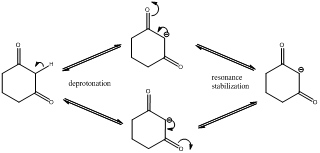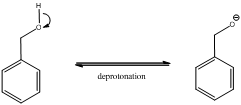
(a)
Interpretation:
To identify which of the given set of compounds have pKa value lesser than 20 and to identify the acidic proton in the same
Concept introduction:
pKa is negative base-10 logarithm of the dissociation constant of acid (Ka) of a solution.
pKa is used is to describe acid dissociation because it is expressed in small decimal numbers.
If pKa value is below 20 the compound is said to have acidic proton and vice versa
To identify : The compound pKa value and the most acidic proton

(a)
Answer to Problem 47PP
The pKa value of (a) is just below 20 and it has acidic proton next to carbonyl
Explanation of Solution
Deprotonation of the highlighted hydrogen and resonance stabilization

From the above scheme we can infer that the highlighted hydrogen is removed resulting in formation of a conjugate base. The conjugate base is resonance stabilized as the negative charge is delocalized on oxygen atom also. Therefore the highlighted proton is most acidic (pKa value below 20) as the removal of it leads to a stabilized conjugate base.
(b)
Interpretation:
To identify which of the given set of compounds have pKa value lesser than 20 and to identify the acidic proton in the same
Concept introduction:
pKa is negative base-10 logarithm of the dissociation constant of acid (Ka) of a solution.
pKa is used is to describe acid dissociation because it is expressed in small decimal numbers.
If pKa value is below 20 the compound is said to have acidic proton and vice versa
To identify : The compound pKa value and the most acidic proton

(b)
Answer to Problem 47PP
The pKa value of (b) is just above 20 and it does not have acidic proton
No acidic proton is present
Explanation of Solution
The above given compound does not have an acidic proton that can undergo deprotonation. Hence this compound is expected to have pKa above 20.
(c)
Interpretation:
To identify which of the given set of compounds have pKa value lesser than 20 and to identify the acidic proton in the same
Concept introduction:
pKa is negative base-10 logarithm of the dissociation constant of acid (Ka) of a solution.
pKa is used is to describe acid dissociation because it is expressed in small decimal numbers.
If pKa value is below 20 the compound is said to have acidic proton and vice versa
To identify : The compound pKa value and the most acidic proton

(c)
Answer to Problem 47PP
The pKa value of (c) is just below 20 and it has acidic proton next to carbonyl
Explanation of Solution
Deprotonation of the highlighted hydrogen and resonance stabilization

From the above scheme we can infer that the highlighted hydrogen is removed resulting in formation of a conjugate base. The conjugate base is resonance stabilized as the negative charge is delocalized on oxygen atom also. Therefore the highlighted proton is most acidic (pKa value below 20) as the removal of it leads to a stabilized conjugate base.
(d)
Interpretation:
To identify which of the given set of compounds have pKa value lesser than 20 and to identify the acidic proton in the same
Concept introduction:
pKa is negative base-10 logarithm of the dissociation constant of acid (Ka) of a solution.
pKa is used is to describe acid dissociation because it is expressed in small decimal numbers.
If pKa value is below 20 the compound is said to have acidic proton and vice versa
To identify : The compound pKa value and the most acidic proton

(d)
Answer to Problem 47PP
The pKa value of (d) is just below 20 and it has acidic proton next to carbonyl
Explanation of Solution
Deprotonation of the highlighted hydrogen and resonance stabilization

From the above scheme we can infer that the highlighted hydrogen is removed resulting in formation of a conjugate base. The conjugate base is resonance stabilized as the negative charge is delocalized on two oxygen atoms (doubly stabilized enolate ion). Therefore the highlighted proton is most acidic (pKa value below 20) as the removal of it leads to a stabilized conjugate base.
(e)
Interpretation:
To identify which of the given set of compounds have pKa value lesser than 20 and to identify the acidic proton in the same
Concept introduction:
pKa is negative base-10 logarithm of the dissociation constant of acid (Ka) of a solution.
pKa is used is to describe acid dissociation because it is expressed in small decimal numbers.
If pKa value is below 20 the compound is said to have acidic proton and vice versa
To identify : The compound pKa value and the most acidic proton

(e)
Answer to Problem 47PP
The pKa value of (e) is just below 20 and it has acidic proton next to carbonyl
Explanation of Solution
Deprotonation of the highlighted hydrogen

From the above scheme we can infer that the highlighted hydrogen is removed resulting in formation of an alokoxide ion. As such the compound is expected to have pKa lower than 20.
Want to see more full solutions like this?
Chapter 21 Solutions
Organic Chemistry
- Give the chemical equation for the preparation of: -Any aldehyde -Any keytonearrow_forward+ C8H16O2 (Fatty acid) + 11 02 → 8 CO2 a. Which of the above are the reactants? b. Which of the above are the products? H2o CO₂ c. Which reactant is the electron donor? Futty acid d. Which reactant is the electron acceptor? e. Which of the product is now reduced? f. Which of the products is now oxidized? 02 #20 102 8 H₂O g. Where was the carbon initially in this chemical reaction and where is it now that it is finished? 2 h. Where were the electrons initially in this chemical reaction and where is it now that it is finished?arrow_forward→ Acetyl-CoA + 3NAD+ + 1FAD + 1ADP 2CO2 + CoA + 3NADH + 1FADH2 + 1ATP a. Which of the above are the reactants? b. Which of the above are the products? c. Which reactant is the electron donor? d. Which reactants are the electron acceptors? e. Which of the products are now reduced? f. Which product is now oxidized? g. Which process was used to produce the ATP? h. Where was the energy initially in this chemical reaction and where is it now that it is finished? i. Where was the carbon initially in this chemical reaction and where is it now that it is finished? j. Where were the electrons initially in this chemical reaction and where is it now that it is finished?arrow_forward
- Rank each of the following substituted benzene molecules in order of which will react fastest (1) to slowest (4) by electrophilic aromatic substitution. OCH 3 (Choose one) OH (Choose one) Br (Choose one) Explanation Check NO2 (Choose one) © 2025 McGraw Hill LLC. All Rights Reserved. Terms of Use | Privacy Center | Aarrow_forwardFor each of the substituted benzene molecules below, determine the inductive and resonance effects the substituent will have on the benzene ring, as well as the overall electron-density of the ring compared to unsubstituted benzene. Molecule Inductive Effects O donating O withdrawing O no inductive effects Resonance Effects Overall Electron-Density ○ donating ○ withdrawing O no resonance effects O electron-rich O electron-deficient O similar to benzene Cl O donating O withdrawing ○ donating ○ withdrawing O no inductive effects O no resonance effects O Explanation Check O electron-rich O electron-deficient similar to benzene X © 2025 McGraw Hill LLC. All Rights Reserved. Terms of Use | Privacy Center | Accessarrow_forwardIdentifying electron-donating and For each of the substituted benzene molecules below, determine the inductive and resonance effects the substituent will have on the benzene ring, as well as the overall electron-density of the ring compared to unsubstituted benzene. Molecule Inductive Effects NH2 ○ donating NO2 Explanation Check withdrawing no inductive effects Resonance Effects Overall Electron-Density ○ donating O withdrawing O no resonance effects O donating O withdrawing O donating withdrawing O no inductive effects Ono resonance effects O electron-rich electron-deficient O similar to benzene O electron-rich O electron-deficient O similar to benzene olo 18 Ar 2025 McGraw Hill LLC. All Rights Reserved. Terms of Use | Privacy Center | Accessibilityarrow_forward
- Rank each of the following substituted benzene molecules in order of which will react fastest (1) to slowest (4) by electrophilic aromatic substitution. Explanation Check Х (Choose one) OH (Choose one) OCH3 (Choose one) OH (Choose one) © 2025 McGraw Hill LLC. All Rights Reserved. Terms of Use | Privacy Centerarrow_forwardAssign R or S to all the chiral centers in each compound drawn below porat bg 9 Br Brarrow_forwarddescrive the energy levels of an atom and howan electron moces between themarrow_forward
 ChemistryChemistryISBN:9781305957404Author:Steven S. Zumdahl, Susan A. Zumdahl, Donald J. DeCostePublisher:Cengage Learning
ChemistryChemistryISBN:9781305957404Author:Steven S. Zumdahl, Susan A. Zumdahl, Donald J. DeCostePublisher:Cengage Learning ChemistryChemistryISBN:9781259911156Author:Raymond Chang Dr., Jason Overby ProfessorPublisher:McGraw-Hill Education
ChemistryChemistryISBN:9781259911156Author:Raymond Chang Dr., Jason Overby ProfessorPublisher:McGraw-Hill Education Principles of Instrumental AnalysisChemistryISBN:9781305577213Author:Douglas A. Skoog, F. James Holler, Stanley R. CrouchPublisher:Cengage Learning
Principles of Instrumental AnalysisChemistryISBN:9781305577213Author:Douglas A. Skoog, F. James Holler, Stanley R. CrouchPublisher:Cengage Learning Organic ChemistryChemistryISBN:9780078021558Author:Janice Gorzynski Smith Dr.Publisher:McGraw-Hill Education
Organic ChemistryChemistryISBN:9780078021558Author:Janice Gorzynski Smith Dr.Publisher:McGraw-Hill Education Chemistry: Principles and ReactionsChemistryISBN:9781305079373Author:William L. Masterton, Cecile N. HurleyPublisher:Cengage Learning
Chemistry: Principles and ReactionsChemistryISBN:9781305079373Author:William L. Masterton, Cecile N. HurleyPublisher:Cengage Learning Elementary Principles of Chemical Processes, Bind...ChemistryISBN:9781118431221Author:Richard M. Felder, Ronald W. Rousseau, Lisa G. BullardPublisher:WILEY
Elementary Principles of Chemical Processes, Bind...ChemistryISBN:9781118431221Author:Richard M. Felder, Ronald W. Rousseau, Lisa G. BullardPublisher:WILEY





